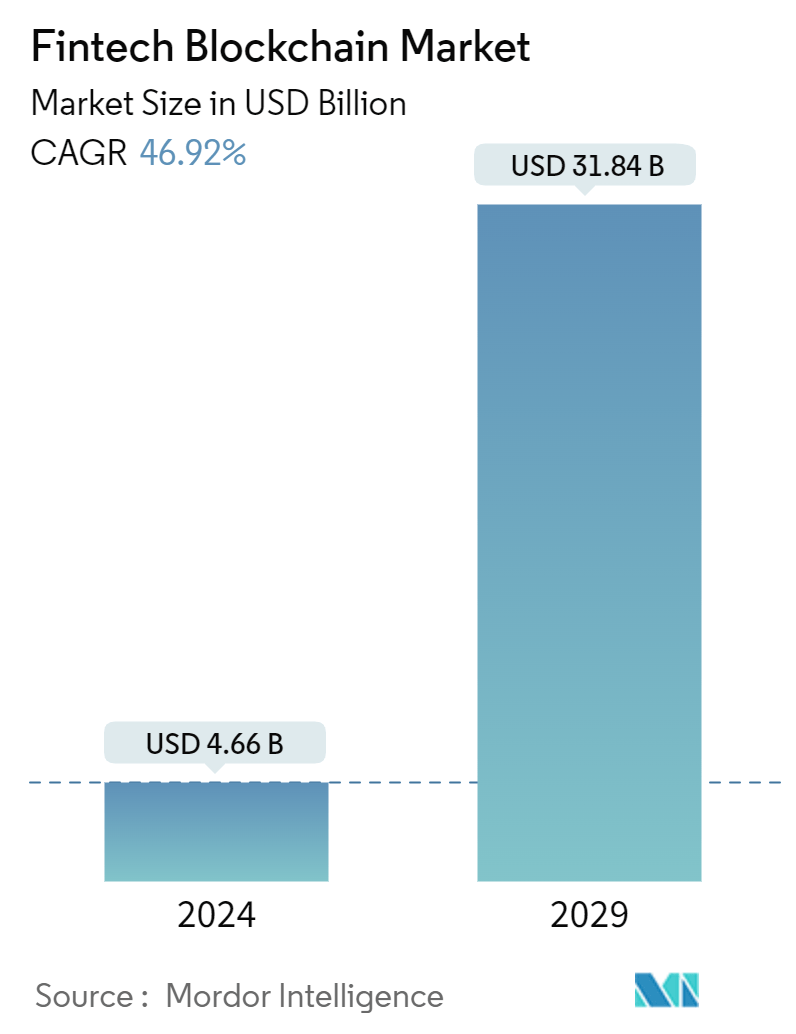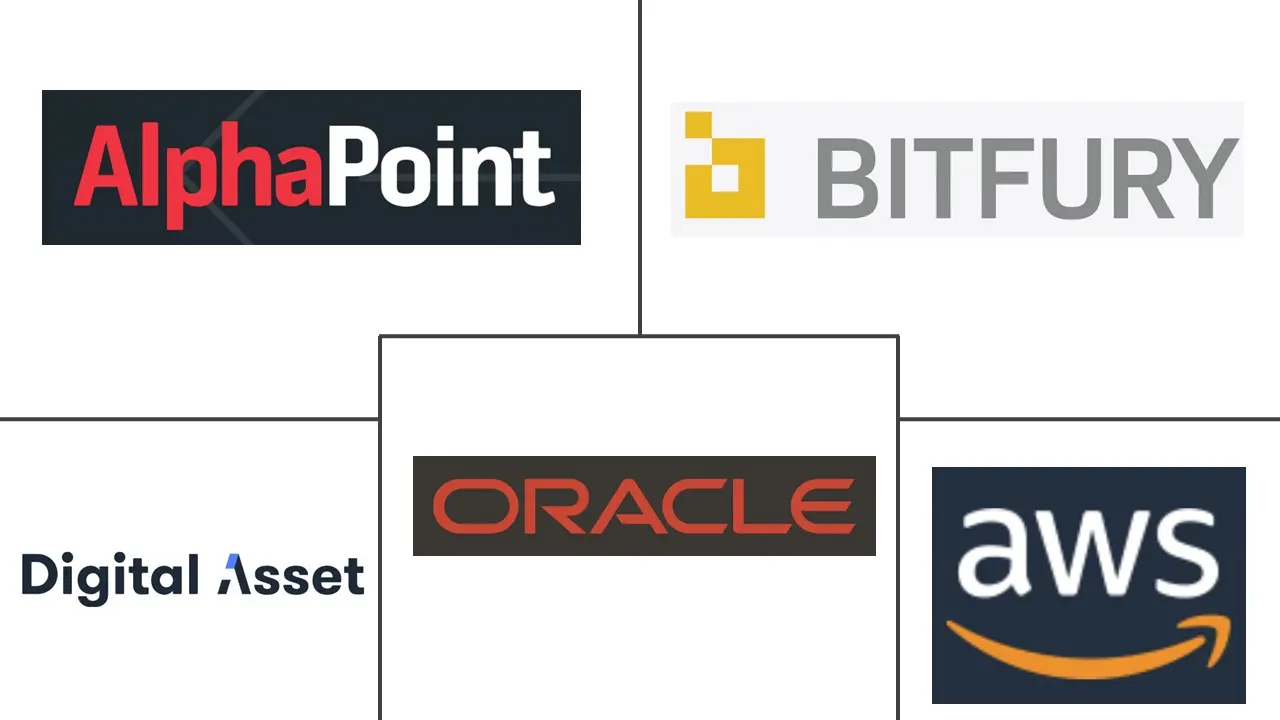Market Size of Fintech Blockchain Industry

| Study Period | 2019 - 2029 |
| Market Size (2024) | USD 4.66 Billion |
| Market Size (2029) | USD 31.84 Billion |
| CAGR (2024 - 2029) | 46.92 % |
| Fastest Growing Market | North America |
| Largest Market | Asia Pacific |
| Market Concentration | Low |
Major Players
*Disclaimer: Major Players sorted in no particular order |
Fintech Blockchain Market Analysis
The Fintech Blockchain Market size is estimated at USD 4.66 billion in 2024, and is expected to reach USD 31.84 billion by 2029, growing at a CAGR of 46.92% during the forecast period (2024-2029).
The blockchain-related fintech industry has been experiencing growth due to various factors, such as the rising market cap of cryptocurrencies and ICOs, increasing demand for distributed ledger technology, and adoption of advanced blockchain solutions in financial institutions. The financial industry's digital transformation is also contributing to the growth of the fintech blockchain, as digital banking technologies and automated chatbots for customer service are experiencing rising demand.
The adoption of cryptocurrencies and digital tokens for making payments is expected to boost the market growth. Many fintech organizations have also started adopting blockchain technology to simplify business procedures, reduce fraudulent activity, and enhance customer service quality. Ripple and other blockchain-based platforms are gaining interest, which is anticipated to lead to greater acceptance in the future. Stablecoins are also gaining popularity as they increase liquidity, cost savings, and stability, and they are a fascinating example of DeFi protocols.
Increased operational efficiency, faster transactions, enhanced security, compliance benefits, infrastructure cost savings, improved cross-border transactions, financial inclusion, and increased competition and innovation drive the reduced total cost of ownership in the fintech blockchain market.
Various organizations are adopting blockchain in trade and finance systems to build smart contracts between participants, increase efficiency and transparency, and offer newer revenue opportunities. Blockchain's identical recording capabilities make the existing clearing and settlement process redundant. Banks and other financial institutions are adopting blockchain-enabled IDs to identify people. Improved results are from organizations' capacity to foresee emerging trends in financial blockchain applications and develop blockchain functionality.
The lack of clear and consistent regulatory standards makes it difficult for fintech blockchain companies to ensure compliance with various legal companies' work to navigate the evolving regulatory landscape.
The COVID-19 pandemic negatively impacted many industries globally, including blockchain-related fintech industries. Lockdowns and supply chain disruptions made it difficult for industry participants to predict the resurgence of the fintech blockchain industry. However, systemic changes brought on by the crisis are anticipated to impact this market significantly. Despite the challenges, the fintech blockchain market is expected to continue its growth.
Fintech Blockchain Industry Segmentation
Blockchain technology is a decentralized ledger of all transactions across a peer-to-peer network. Through this technology, participants or users can confirm transactions without the need for a central clearing authority. Most of the potential applications include fund transfers, settling trades, voting, and many other issues.
The fintech blockchain market is segmented by provider (middleware providers, application and solution providers, and infrastructure and protocol providers), application (payments, clearing, and settlement, exchanges, and remittance, smart contract, identity management, compliance management/KYC, and other applications), organization size (large enterprises and small and medium-sized enterprises), end-user verticals (banking, non-banking financial services, and insurance), and geography (North America [United States and Canada], Europe [Germany, United Kingdom, France, and Rest of Europe], Asia-Pacific [China, India, Japan, and Rest of Asia Pacific], Latin America, and Middle East and Africa). The market sizes and forecasts are provided in terms of value (USD) for all the above segments.
| By Provider | |
| Middleware Providers | |
| Application and Solution Providers | |
| Infrastructure and Protocol Providers |
| By Application | |
| Payments, Clearing, and Settlement | |
| Exchanges and Remittance | |
| Smart Contract | |
| Identity Management | |
| Compliance Management/ KYC | |
| Other Applications |
| By Organization Size | |
| Large Enterprises | |
| Small and Medium-sized Enterprises |
| By End-user Verticals | |
| Banking | |
| Non-banking Financial Services | |
| Insurance |
| By Geography*** | |||||
| |||||
| |||||
| |||||
| Australia and New Zealand | |||||
| Latin America | |||||
| Middle East and Africa |
Fintech Blockchain Market Size Summary
The fintech blockchain market is poised for significant expansion, driven by the increasing integration of blockchain technology within the financial services sector. This growth is fueled by the rising market capitalization of cryptocurrencies, the demand for distributed ledger technology, and the digital transformation of financial institutions. The adoption of advanced blockchain solutions is enhancing operational efficiency, security, and customer service quality. The market is also witnessing a surge in the use of cryptocurrencies and digital tokens for payments, alongside the growing popularity of stablecoins, which offer liquidity and stability. These developments are encouraging fintech organizations to streamline business processes, reduce fraud, and improve service delivery. The market's trajectory is further supported by the adoption of blockchain in trade and finance systems, which is enhancing transparency and creating new revenue opportunities.
Despite challenges such as regulatory uncertainties and the impact of the COVID-19 pandemic, the fintech blockchain market is expected to continue its upward trend. The pandemic has accelerated the demand for digital transformation, particularly in the banking sector, where online services have become essential. Blockchain technology is also transforming the insurance industry by providing transparent and trustworthy transaction records, which enhance efficiency and reduce costs. The market is characterized by the presence of major players like AlphaPoint Corporation, Bitfury Group Limited, and Oracle Corporation, who are leveraging partnerships and acquisitions to strengthen their offerings. Collaborations, such as those between Cponcover and AlphaPoint, and Axelar and Microsoft, are enhancing security and scalability, further driving market growth. As companies expand, the need for scalable, cloud-based solutions is becoming increasingly important, offering cost-effective and secure management of large data volumes.
Fintech Blockchain Market Size - Table of Contents
-
1. MARKET INSIGHTS
-
1.1 Market Overview
-
1.2 Industry Attractiveness - Porter's Five Forces Analysis
-
1.2.1 Bargaining Power of Suppliers
-
1.2.2 Bargaining Power of Consumers
-
1.2.3 Threat of New Entrants
-
1.2.4 Threat of Substitute Products
-
1.2.5 Intensity of Competitive Rivalry
-
-
1.3 Assessment of the Impact of COVID-19 on the Industry
-
-
2. MARKET SEGMENTATION
-
2.1 By Provider
-
2.1.1 Middleware Providers
-
2.1.2 Application and Solution Providers
-
2.1.3 Infrastructure and Protocol Providers
-
-
2.2 By Application
-
2.2.1 Payments, Clearing, and Settlement
-
2.2.2 Exchanges and Remittance
-
2.2.3 Smart Contract
-
2.2.4 Identity Management
-
2.2.5 Compliance Management/ KYC
-
2.2.6 Other Applications
-
-
2.3 By Organization Size
-
2.3.1 Large Enterprises
-
2.3.2 Small and Medium-sized Enterprises
-
-
2.4 By End-user Verticals
-
2.4.1 Banking
-
2.4.2 Non-banking Financial Services
-
2.4.3 Insurance
-
-
2.5 By Geography***
-
2.5.1 North America
-
2.5.1.1 United States
-
2.5.1.2 Canada
-
-
2.5.2 Europe
-
2.5.2.1 Germany
-
2.5.2.2 United Kingdom
-
2.5.2.3 France
-
-
2.5.3 Asia
-
2.5.3.1 China
-
2.5.3.2 India
-
2.5.3.3 Japan
-
-
2.5.4 Australia and New Zealand
-
2.5.5 Latin America
-
2.5.6 Middle East and Africa
-
-
Fintech Blockchain Market Size FAQs
How big is the Fintech Blockchain Market?
The Fintech Blockchain Market size is expected to reach USD 4.66 billion in 2024 and grow at a CAGR of 46.92% to reach USD 31.84 billion by 2029.
What is the current Fintech Blockchain Market size?
In 2024, the Fintech Blockchain Market size is expected to reach USD 4.66 billion.

